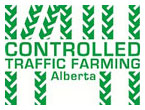Agronomist Notes
Hello Reader
I’ve been away this week attending the Global Farmer Round Table in conjunction with the World Food Prize in Des Moines, Iowa. There are sixteen farmers in attendance from fifteen countries spanning six continents. I’m honored to be representing Canada. We have gathered to talk about the challenges we face as we look to feed 9 billion people by 2050. It’s been an awesome privilege to sit down and share ideas with a feedlot owner from Indonesia, a dairy owner from China, a grain grower from India, potato grower from Argentina and all points in between. What an amazing experience. On the farming side, I’d like to point out that some grain companies are offering zero basis levels already, with harvest just about wrapped up. That, my friend, is a very good sign! Farmers aren’t selling into this falling market so friendly basis levels are trying to encourage us. I hope we can capture the low basis levels and catch some rallies in the next few months to soften the blow from the decline in commodity prices.
This week we’ll be looking at the results from our in-furrow fungicide trial in wheat. Next, I’ve got some great information comparing land costs and returns from five different grain-growing countries. I’ll share some factoids I’ve learned during my time at the World Food Prize and last I’ll share a few recent Nuffield reports on hitting 20 tonne wheat yields and another on communication inside a growing farm business.
Have a great week.

Harvest Progress
(Calgary to Drumheller to Three Hills)Crop Complete
Wheat: 98%
Barley: 100%
Canola: 98%
Peas: 100%
In-furrow fungicide shows promise
We’ve been investigating the use of in-furrow liquid fungicides as a tool to compliment or replace fungicidal seed treatments in cereals. With tight wheat rotations we thought in some cases, an in-furrow fungicide would give us stronger, longer lasting disease protection. This practice is common in other parts of the world (see here) With that, we decided to investigate this practice at our place.
In 2014, we set up a simple side-by-side trial in a field with a wheat-canola-wheat rotation, which would be ideal for a response to fungicide. Here are the details:
Details
Seeding date: May 19th
Variety: Sadash soft white spring wheat
Seed treatment: Vibrance XL
In-furrow fungicide: Prosaro 200 ml/ac (prothioconazole + tebuconazole)
Fertility: 60-30-0-20 at seeding
Fertility: 120 N side dressed at GS31
Fungicide: Folicur EW at head emergence
There was a moderate level of septoria and tan spot on the bottom leaves at GS30 with septoria being the most prevalent. At the time I measured the percentage difference in leaf disease at GS30, I found very little difference between the in-furrow treatment and the check. However, after reviewing my NDVI imagery taken at GS31 with our GreenSeeker, the 27-acre trial block could be easily picked out. You can see in the image above there is a straight line on the east side of the treatment block where the trial started and ended. The west (left) side of the treatment could be seen but not as defined. You could clearly see the elevated NDVI inside the treatment block compared to anywhere else in the field.
Yield
In-furrow Prosaro: 101 bu/ac or 2.74 T/ac
Check: 95 bu/ac or 2.58 T/ac
In-furrow fungicide cost: $10.60/ac
Yield increase: 6 bu/ac x $4.20/bu = $25.20/ac
Net profit: $14.60
It was clear that an in-furrow treatment of Prosaro provided an excellent return on investment by turning a $10 fungicide application into a $25 return. That said, however, the conditions were ideal for a response to occur with wet weather during crop establishment and a tight wheat rotation. I don’t know how consistent the results would be outside of a tight rotation where disease risk may not be as high.
For now, in-furrow fungicides are not registered in Western Canada but I do believe they have a fit. There has been plenty of research done in other parts of the world and I encourage you to read the link above that discusses diseases and the fungicide actives used in furrow. I know on our farm we will be trialing a few more crops next year and I will engage the farming and research community to see if they can do the same. SL
Are land costs high in your country?
Farmers compare notes
There is one thing farmers like talking about more than the weather and that is land price. We’re always curious to know who has the competitive edge or who might make us feel better about how well off we are. This week I had the good fortune to sit down with farmers from Argentina, England, New Zealand and the United States. For a simple exercise we all gave examples of land costs and the gross returns we could generate on that land.We standardized our measure to USD per hectare. We also took average land prices in our regions and the returns we could generate with the crops we grow in the last 5 years. Here are the interesting details:
Country $/ha Land $/ha Gross $/ha Land rent Interest cost
Argentina $7,000 $2,600 $360 20% (!!!)
Canada $8,600 $1,000 $170 5.0%
England $37,500 $2,300 $925 5.5%
New Zealand $42,000 $6,000 $960 6.0%
United States $50,000 $3,000 $600 5.0%
If you look at a simple measure of gross return on land cost (net returns vary by farm) you’ll find that New Zealand and Canada generate the highest gross returns on land values at 14% and 11% respectively. Argentina, England and the US are neck in neck at 5-6% gross return on land value. This is a crude measure but a relative one.
The next measure we looked at was land rent versus the cost of land, which is a better measure of return on land values. The clear winner was Argentina with a 5% return on land cost based on rental values. England and New Zealand were very close at 2.3% and 2.4% respectively. The countries with the lowest rental incomes were United States and Canada with 1.2% and 1.9% respectively.
It’s any wonder why competition to buy farmland has been so fierce. To cover both interest and inflation you would have to see land in any country appreciate by at least 5% annually on top of the rental income to breakeven. With record low interest rates and rising land values, it has made it possible for public and private investors to view farmland as a viable investment.
What sticks out the most is Argentina’s interest cost at a staggering 20%! Oddly enough I was told their inflation rate is 35% so 20% interest isn’t bad, considering. However, it is very hard to borrow money in Argentina and most rely on their own capital to fund land purchases not the banks so interest rates are almost a moot point.
In the end, we all have our own challenges but a few things are clear. No matter what the subsidy or climate, you can rent land for 1.2%-2.4% of its value. In spite of high land costs, good farm managers/owners continue to expand and generate a profit. Low interest rates and decent land appreciation will put pressure on farmers to compete with outside investors who look to farmland as a solid investment. It amazed me that in the face of huge land prices, equipment and input costs and the potential for low returns, every farmer with me around that table saw potential and opportunity all around them. Now, how about this weather. SL
World Food Prize factoids
Once you’ve finished hashing out the current weather situation with your neighbor, you might deliberate one or two of the following points I came across this week. I gleaned these while attending this year’s World Food Prize. In no particular order here they are, seeds for deep thought:
- Aquaculture is the fastest growing food production sector in the world.
- World food demand will double by 2050 with a population increase of 50%.
- 40% of the world’s soil used for agriculture is classified as degraded or seriously degraded.
- Today’s 7 billion people are fed on arable land that covers 10.6% of the worlds land area.
- 900 million people who live on less than $2/day use corn as their staple food.
- Corn, rice and wheat provide 30% of the calories for 4.5 billion people in developing countries.
- Corn yields need to increase by 60% by 2050 to meet demand.
- Wheat yield need to increase by 60% by 2050 to meet demand.
- Wheat is grown on 215 million hectares globally.
- 8/15 years, world wheat production has fallen short of demand.
- China, the largest producer of wheat will lose 30% of its wheat yield if current varieties and practices remain. SL
Nuffield Reports
I always enjoy when Nuffield Reports come across my desk. Especially when they involve wheat and weather! Here are two good reads that were published recently."Breaking the wheat yield plateau in the UK" by Jake Freestone
“Zero tillage, longer and more diverse rotations, cover crops and livestock integration are the key factors to increase yields and are in the farmer's own control.”
Report online
"It’s time to talk: communicating with staff in a growing farming business" by John Millington
“The most successful managers place greater importance on making time for communication.”
Report online





